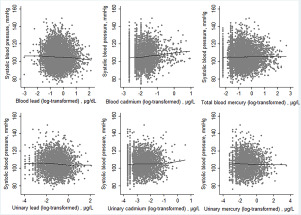当前位置:
X-MOL 学术
›
Sci. Total Environ.
›
论文详情
Our official English website, www.x-mol.net, welcomes your
feedback! (Note: you will need to create a separate account there.)
Relationship between low-level lead, cadmium and mercury exposures and blood pressure in children and adolescents aged 8-17 years: An exposure-response analysis of NHANES 2007-2016.
Science of the Total Environment ( IF 8.2 ) Pub Date : 2020-04-04 , DOI: 10.1016/j.scitotenv.2020.138446 Baodong Yao 1 , Xiaojing Lu 2 , Lai Xu 2 , Yue Wang 1 , Huiyan Qu 1 , Hua Zhou 1
Science of the Total Environment ( IF 8.2 ) Pub Date : 2020-04-04 , DOI: 10.1016/j.scitotenv.2020.138446 Baodong Yao 1 , Xiaojing Lu 2 , Lai Xu 2 , Yue Wang 1 , Huiyan Qu 1 , Hua Zhou 1
Affiliation

|
This study investigated whether low-level blood and urinary lead, cadmium and mercury exposures were associated with blood pressure (BP) in children and adolescents. Data from National Health and Nutrition Examination Survey (NHANES) between 2007 and 2016 for children and adolescents aged 8-17 years (n = 7076) were analyzed. Outcome variables were systolic BP, diastolic BP and high BP status. High BP was defined as: self-reported antihypertensive medication usage or a diagnosis of hypertension; classified as having elevated BP/hypertension according to 2017 AAP guidelines. Multivariable linear and logistic regressions models were performed and stratified by race/ethnicity and gender. Blood lead was negatively associated with diastolic BP among blacks, and positively associated with diastolic BP among whites. For a two-fold increase of blood lead concentration, the change in diastolic BP was -1.59 mm Hg (95% CI: -3.04 to -0.16 mm Hg) among blacks and 1.38 mm Hg (95% CI: 0.40 to 2.36 mm Hg) among whites. No significant associations between either systolic BP or diastolic BP with urinary lead were observed. The inverse associations between blood lead and high BP were found in females, Mexican Americans and other Hispanics. No associations between blood cadmium and BP were observed, except in other Hispanics. Urinary cadmium levels were inversely correlated with systolic BP, diastolic BP and high BP in all participants and in men. When compared to the lowest quartile of urinary cadmium levels, participants with a urinary cadmium level ≥ 0.12 μg/L had 0.48 (95% CI: 0.29-0.78) times and 0.53 (95% CI: 0.30-0.94) times reduced odds of having high BP in all participants and in men, respectively. No associations between either blood mercury or urinary mercury with systolic BP were observed. Significant inverse associations were found between blood total mercury and methyl mercury with diastolic BP in all participants and in men. Future prospective studies are warranted to confirm these findings.
中文翻译:

8-17岁儿童和青少年的低铅,镉和汞暴露与血压之间的关系:NHANES 2007-2016的暴露-反应分析。
这项研究调查了低水平的血液和尿铅,镉和汞的暴露是否与儿童和青少年的血压(BP)相关。分析了2007年至2016年美国国家健康和营养调查(NHANES)收集的8-17岁儿童和青少年(n = 7076)的数据。结果变量为收缩压,舒张压和高血压状态。高血压定义为:自我报告的抗高血压药物的使用或高血压的诊断;根据2017 AAP指南归类为BP /高血压升高。进行了多元线性和逻辑回归模型,并按种族/民族和性别进行了分层。黑人中血铅与舒张压呈负相关,白人与舒张压呈正相关。对于血铅浓度增加两倍的情况,黑人中舒张压BP的变化为-1.59 mm Hg(95%CI:-3.04至-0.16 mm Hg)和1.38 mm Hg(95%CI:0.40至2.36 mm Hg) )在白人之中。没有观察到收缩压或舒张压与尿铅之间的显着关联。在女性,墨西哥裔美国人和其他西班牙裔中发现血铅与高血压之间呈负相关。除其他西班牙裔外,未观察到血镉与血压之间的关联。在所有参与者和男性中,尿镉水平与收缩压,舒张压和高血压成反比。与最低尿镉水平的四分位数相比,尿镉水平≥0.12μg/ L的参与者具有0.48(95%CI:0.29-0.78)倍和0.53(95%CI:0.30-0)。94)分别降低了所有参与者和男性中具有较高BP的几率。血汞或尿汞与收缩压之间无关联。在所有参与者和男性中,血液总汞和甲基汞与舒张压之间存在显着的负相关。保证未来的前瞻性研究可以证实这些发现。
更新日期:2020-04-06
中文翻译:

8-17岁儿童和青少年的低铅,镉和汞暴露与血压之间的关系:NHANES 2007-2016的暴露-反应分析。
这项研究调查了低水平的血液和尿铅,镉和汞的暴露是否与儿童和青少年的血压(BP)相关。分析了2007年至2016年美国国家健康和营养调查(NHANES)收集的8-17岁儿童和青少年(n = 7076)的数据。结果变量为收缩压,舒张压和高血压状态。高血压定义为:自我报告的抗高血压药物的使用或高血压的诊断;根据2017 AAP指南归类为BP /高血压升高。进行了多元线性和逻辑回归模型,并按种族/民族和性别进行了分层。黑人中血铅与舒张压呈负相关,白人与舒张压呈正相关。对于血铅浓度增加两倍的情况,黑人中舒张压BP的变化为-1.59 mm Hg(95%CI:-3.04至-0.16 mm Hg)和1.38 mm Hg(95%CI:0.40至2.36 mm Hg) )在白人之中。没有观察到收缩压或舒张压与尿铅之间的显着关联。在女性,墨西哥裔美国人和其他西班牙裔中发现血铅与高血压之间呈负相关。除其他西班牙裔外,未观察到血镉与血压之间的关联。在所有参与者和男性中,尿镉水平与收缩压,舒张压和高血压成反比。与最低尿镉水平的四分位数相比,尿镉水平≥0.12μg/ L的参与者具有0.48(95%CI:0.29-0.78)倍和0.53(95%CI:0.30-0)。94)分别降低了所有参与者和男性中具有较高BP的几率。血汞或尿汞与收缩压之间无关联。在所有参与者和男性中,血液总汞和甲基汞与舒张压之间存在显着的负相关。保证未来的前瞻性研究可以证实这些发现。











































 京公网安备 11010802027423号
京公网安备 11010802027423号